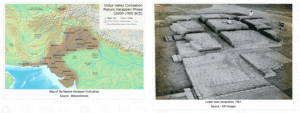TAG: GS-1: Art & culture
The context: A study by the Indian Institute of Technology-Gandhinagar has provided fresh evidence to prove that a dockyard existed at Lothal.
Explanation:
About the Lothal:
The discovery of Lothal, located in the Bhal region of Gujarat during the 1950s, initiated debates among archaeologists about the existence of a dockyard.The IITGn study reveals that the Sabarmati River once flowed close to Lothal during the Harappan period, contrasting its current course, which is 20 km away.
- The study suggests a trade route linking Ahmedabad, through Lothal, Nal Sarovar, and the Little Rann, to Dholavira, another prominent Harappan site.
- Satellite imagery and multi-sensor data analysis have uncovered the ancient channels of the Sabarmati River, confirming Lothal’s strategic location on a significant riverine route.
- The study also suggests that traders might have arrived in Gujarat via the Gulf of Khambhat, collected materials from Ratanpura, and transported them to Mesopotamia (modern-day Iraq).

Urban Planning and Infrastructure:
- Lothal was well-planned, and its design guarded the city from floods. Houses were built on terraced platforms and walled on three sides by a peripheral wall. Houses were arranged in blocks.
- The Harappan custom of dividing the city into acropolis or citadel and lower townwas followed.
- It included the residence of the ruler and provided civic amenities such as metalled roads, underground drains, and wells.
- The lower town was equally well-planned with commercial centers, residential areas, and a dock for berthing ships, so essential to trade.
- An unclogging stormwater/waste disposal system ensured that the town had advanced drainage.
Economic and Industrial Activities
- Lothal was an industrial centre.
- Bronze tools, beads, and ornaments were manufactured in this city.
- It imported copper and semi-precious stones from far-away places.
- Thebead industry had developed as a distinct enterprise.
- Artisans of Lothal produced some beautiful jewellery.
- There was also a well-developed trade network which exported goods to various parts of the Harappan civilization.
Religion and Burial Practices
- Lothal, just like Kalibangan, shows evidence of fire worship through their existence of fire altars in open public places as well as private ones. The people followed a religion that incorporated the worship of various animals, evident on the seals.
- Lothal demonstrates a peculiar way of burial called a joint burial in which a couple are buried together; this could be because of some family tragedies or couple accidents.
Art and Metallurgy
- Among the other great things about Lothal, it also contained seals of steatite with calligraphy and motifs of animals, which reflected the artistic and cultural sophistication of the Harappans.
- On this site also lies much importance in the section of metallurgy as a high-purity copper was imported here to create various types of tools and ornaments.
Decline
- Like the Indus Valley Civilization, Lothal declined due to natural calamities, mainly floods, that swept the town. The economy of the town ground to a halt by 1900 BCE and was consequently abandoned.
Source: https://indianexpress.com/article/explained/explained-sci-tech/dockyard-lothal-gujarat-9548119/
Spread the Word

